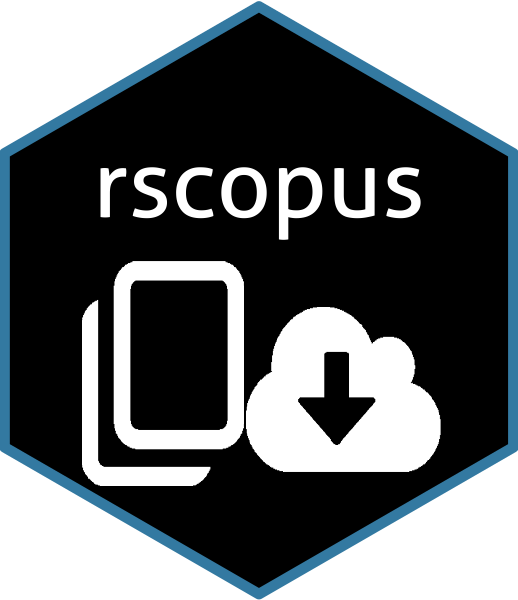R Package to interface with Elsevier and Scopus APIs
The goal of rscopus is to provide an R Scopus Database ‘API’ Interface.
You can install rscopus from github with:
# install.packages("devtools")
devtools::install_github("muschellij2/rscopus")In order to use this package, you need an API key from https://dev.elsevier.com/sc_apis.html. You should login from your institution and go to Create API Key. You need to provide a website URL and a label, but the website can be your personal website, and agree to the terms of service.
- Go to https://dev.elsevier.com/user/login. Login or create a free account.
- Click “Create API Key”. Put in a label, such as
rscopus key. Add a website. http://example.com is fine if you do not have a site. - Read and agree to the TOS if you do indeed agree.
- Add
Elsevier_API = "API KEY GOES HERE"to~/.Renvironfile, or addexport Elsevier_API=API KEY GOES HEREto your~/.bash_profile.
Alternatively, you you can either set the API key using
rscopus::set_api_key or by options("elsevier_api_key" = api_key).
You can access the API key using rscopus::get_api_key.
You should be able to test out the API key using the interactive Scopus APIs.
The API Key is bound to a set of IP addresses, usually bound to your institution. Therefore, if you are using this for a Shiny application, you must host the Shiny application from your institution servers in some way. Also, you cannot access the Scopus API with this key if you are offsite and must VPN into the server or use a computing cluster with an institution IP.
See https://dev.elsevier.com/tecdoc_api_authentication.html
This is a basic example which shows you how to solve a common problem:
library(rscopus)
library(dplyr)
res = author_df(last_name = "Muschelli", first_name = "John", verbose = FALSE, general = FALSE)
#> Warning: 'entries_to_df' is deprecated.
#> Use 'gen_entries_to_df' instead.
#> See help("Deprecated")
names(res)
#> [1] "auth_order" "affilname_1" "n_auth"
#> [4] "affilname_2" "n_affils" "citations"
#> [7] "journal" "description" "title"
#> [10] "pii" "doi" "eid"
#> [13] "cover_date" "cover_display_date" "prism_url"
#> [16] "dc_identifier" "dc_creator" "prism_issn"
#> [19] "prism_eIssn" "prism_pageRange" "dc_description"
#> [22] "prism_aggregationType" "subtype" "authkeywords"
#> [25] "source_id" "first_name" "last_name"
#> [28] "au_id"
head(res[, c("title", "journal", "description")])
#> title
#> 1 “The doctor said formula would help me”: Health sector influences on use of infant formula in peri-urban Lima, Peru
#> 2 Relationship of White Matter Lesions with Intracerebral Hemorrhage Expansion and Functional Outcome: MISTIE II and CLEAR III
#> 3 An improved algorithm of white matter hyperintensity detection in elderly adults
#> 4 Recommendations for Processing Head CT Data
#> 5 crsra: A learning analytics tool for understanding student behaviour in massive open online courses
#> 6 Neuroconductor: An R platform for medical imaging analysis
#> journal description
#> 1 Social Science and Medicine Article
#> 2 Neurocritical Care Article
#> 3 NeuroImage: Clinical Article
#> 4 Frontiers in Neuroinformatics Article
#> 5 Journal of Learning Analytics Article
#> 6 Biostatistics Article
unique(res$au_id)
#> [1] "40462056100"
unique(as.character(res$affilname_1))
#> [1] "Johns Hopkins Bloomberg School of Public Health"
#> [2] "Johns Hopkins University"
#> [3] "Departments of Biostatistics"
#> [4] "Kennedy Krieger Institute"
#> [5] "Johns Hopkins Medical Institutions"
#> [6] "Johns Hopkins School of Medicine"
all_dat = author_data(last_name = "Muschelli",
first_name = "John", verbose = FALSE, general = TRUE)
res2 = all_dat$df
res2 = res2 %>%
rename(journal = `prism:publicationName`,
title = `dc:title`,
description = `dc:description`)
head(res[, c("title", "journal", "description")])
#> title
#> 1 “The doctor said formula would help me”: Health sector influences on use of infant formula in peri-urban Lima, Peru
#> 2 Relationship of White Matter Lesions with Intracerebral Hemorrhage Expansion and Functional Outcome: MISTIE II and CLEAR III
#> 3 An improved algorithm of white matter hyperintensity detection in elderly adults
#> 4 Recommendations for Processing Head CT Data
#> 5 crsra: A learning analytics tool for understanding student behaviour in massive open online courses
#> 6 Neuroconductor: An R platform for medical imaging analysis
#> journal description
#> 1 Social Science and Medicine Article
#> 2 Neurocritical Care Article
#> 3 NeuroImage: Clinical Article
#> 4 Frontiers in Neuroinformatics Article
#> 5 Journal of Learning Analytics Article
#> 6 Biostatistics ArticleAs per https://dev.elsevier.com/tecdoc_api_authentication.html: “Using
a proprietary token (an”Institutional Token“) created for you by our
integration support team”, so you need to contact Scopus to get one. If
you have one and it’s located in an object called token, you should be
able to use it as:
# token is from Scopus dev
hdr = inst_token_header(token)
res = author_df(last_name = "Muschelli", first_name = "John", verbose = FALSE, general = FALSE, headers = hdr)but I have not tried it extensively.
